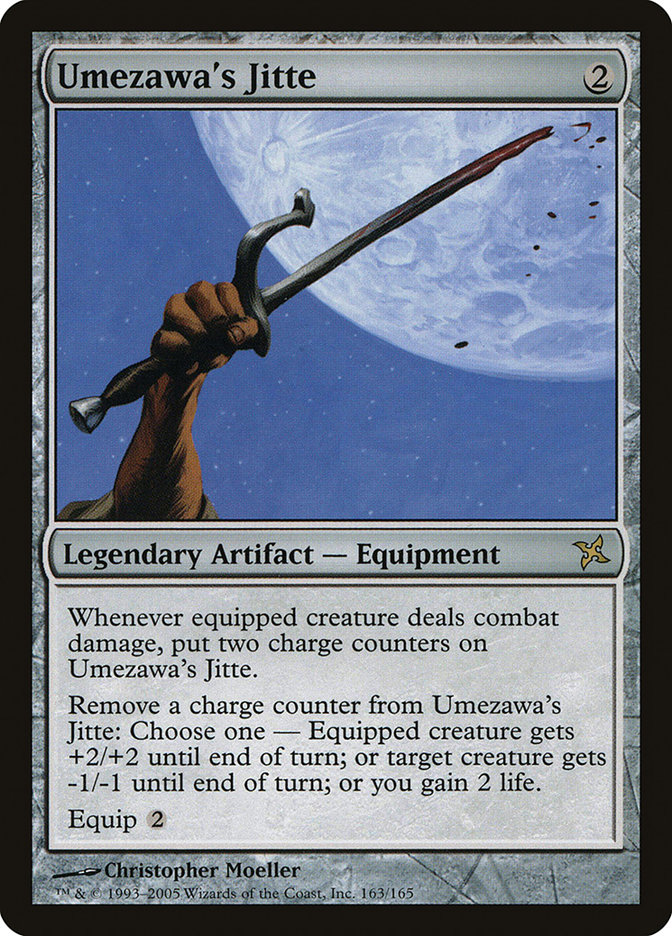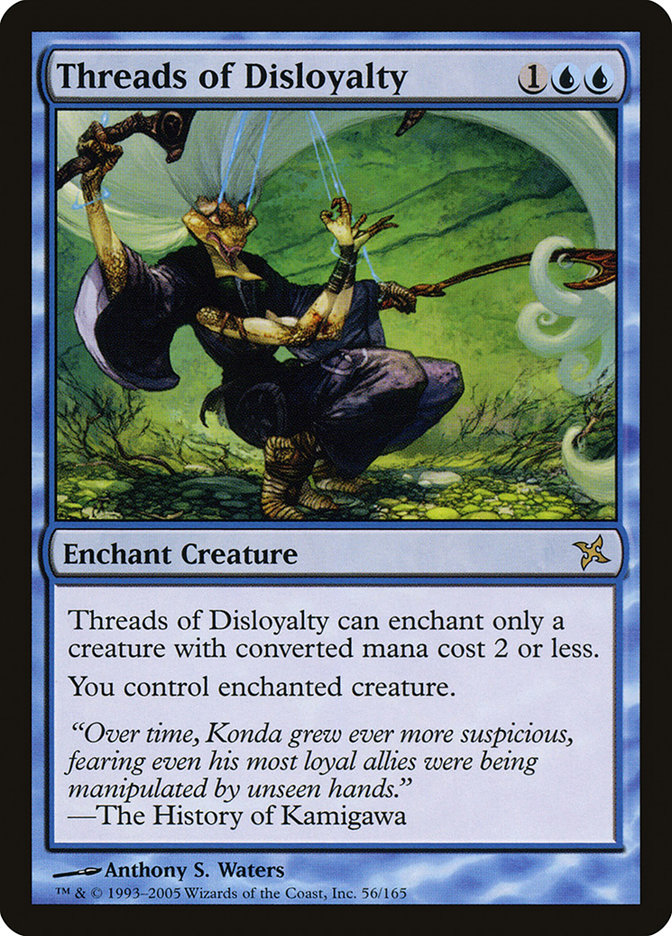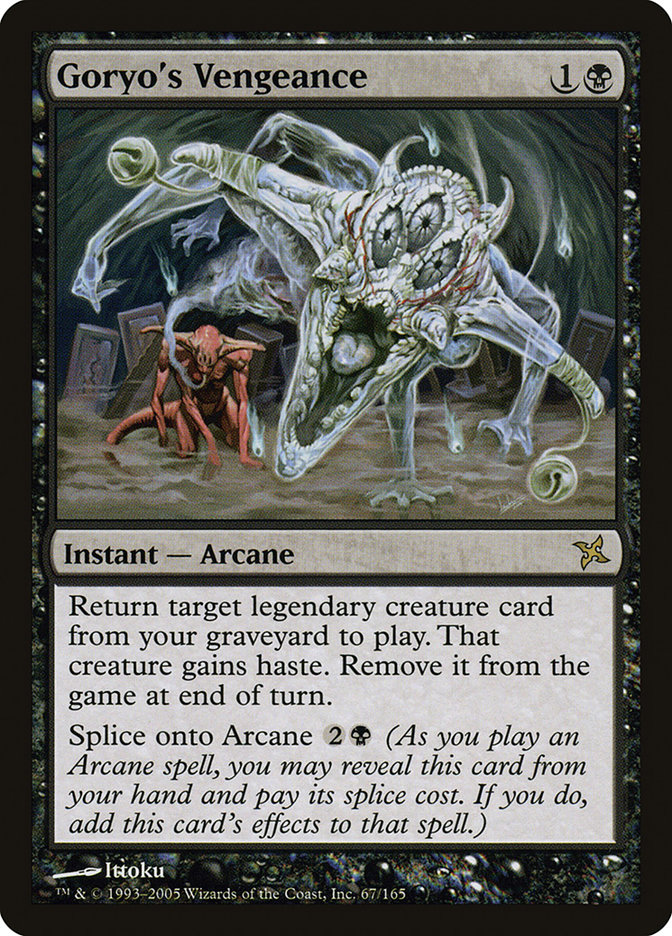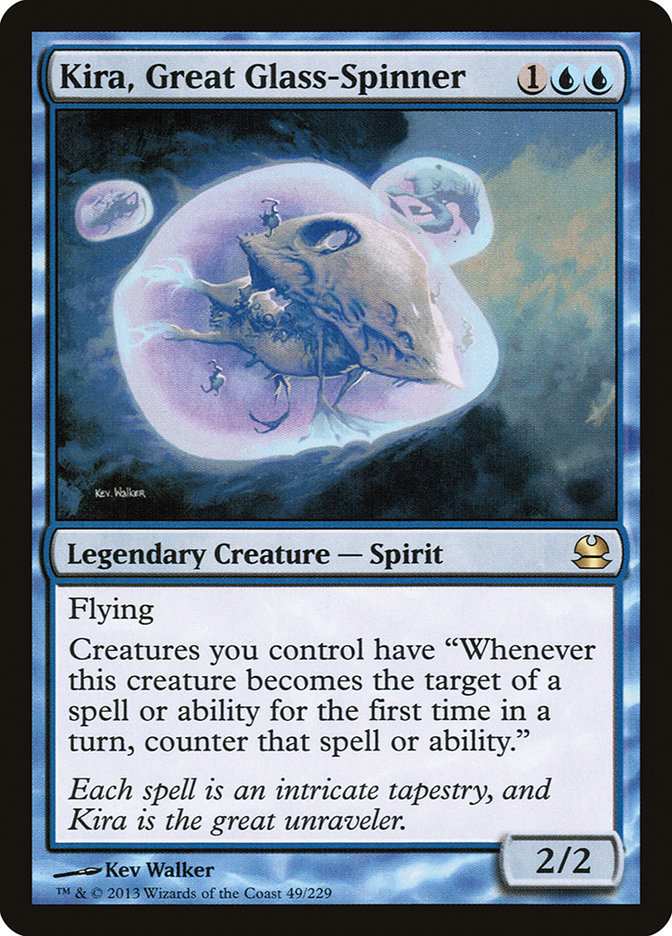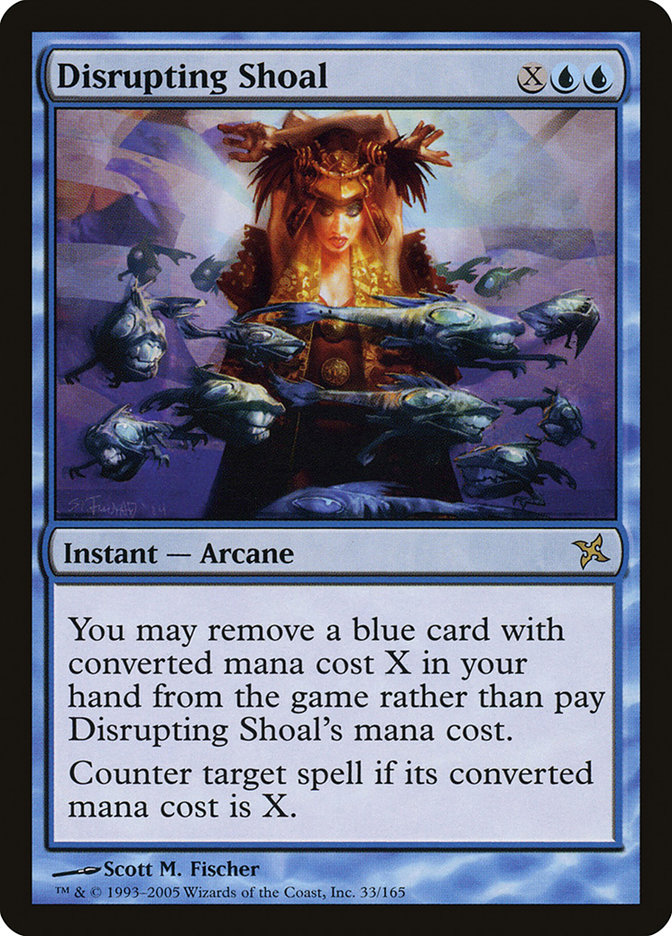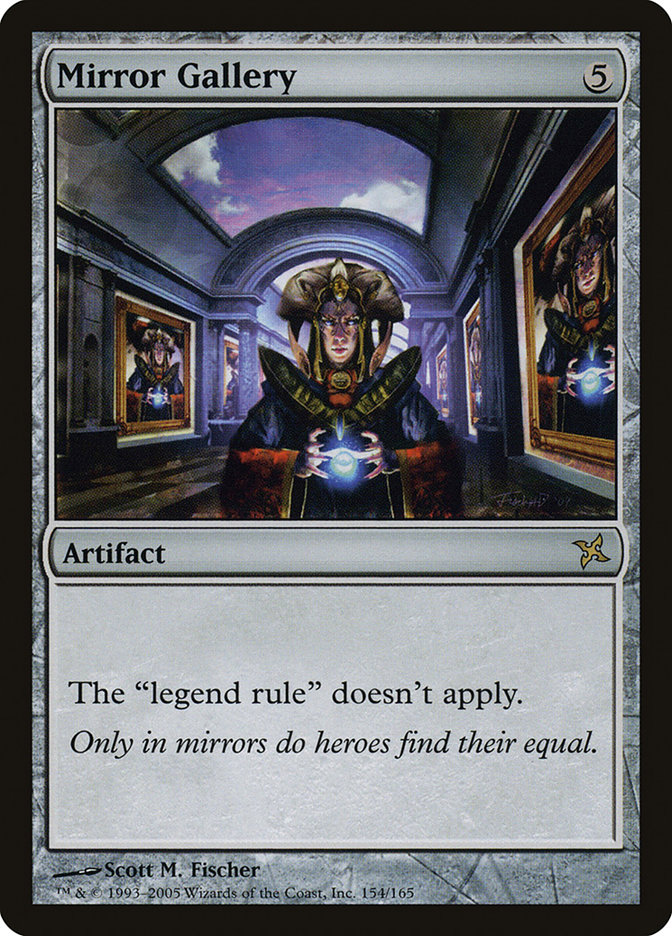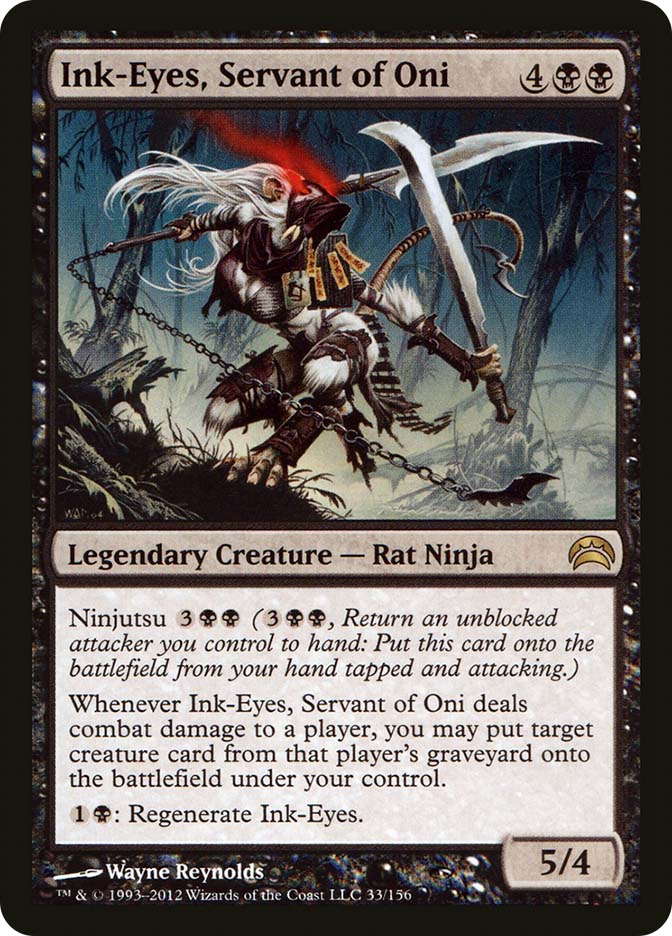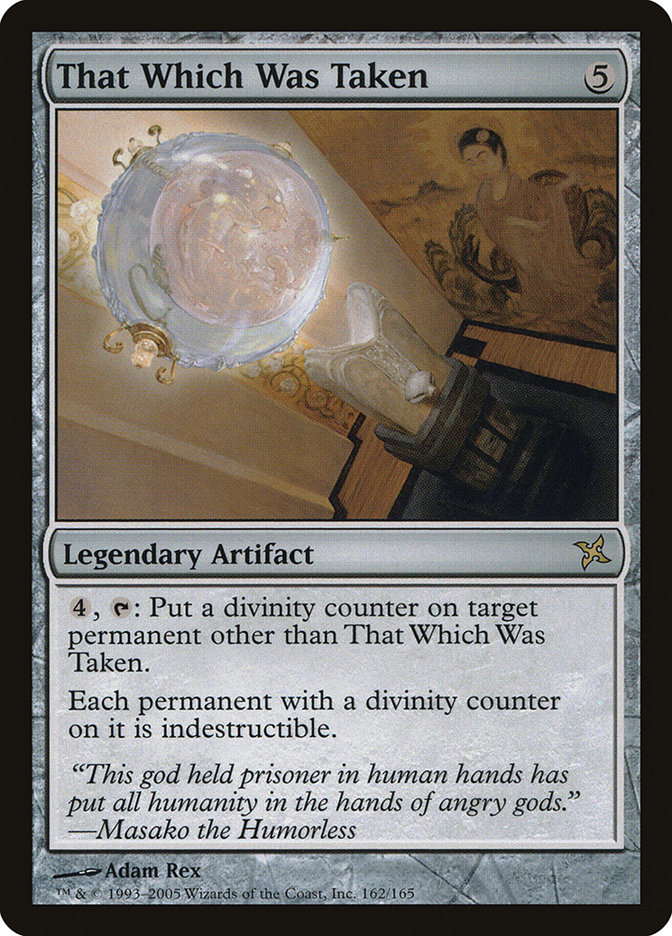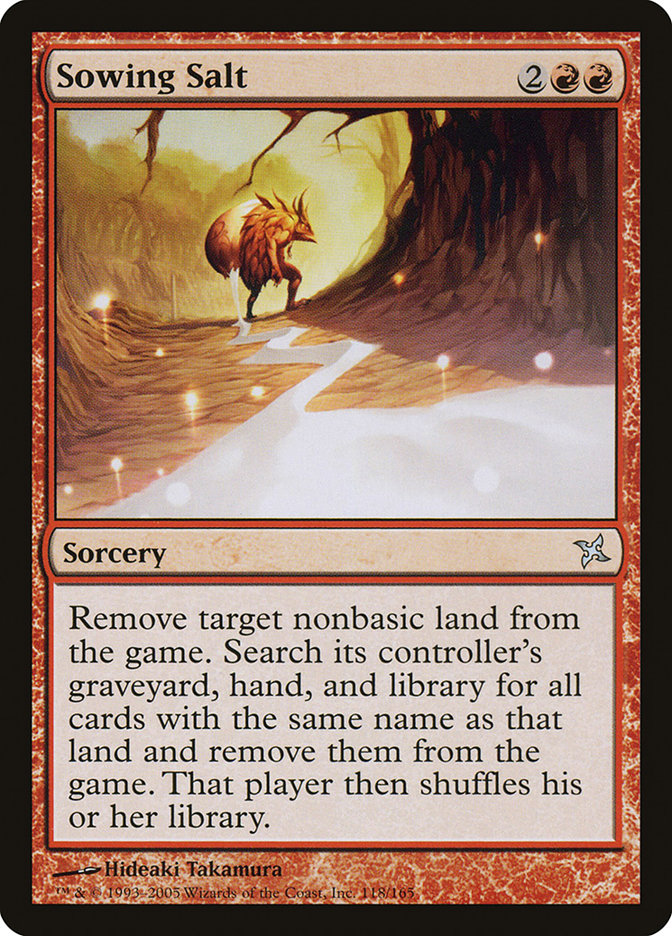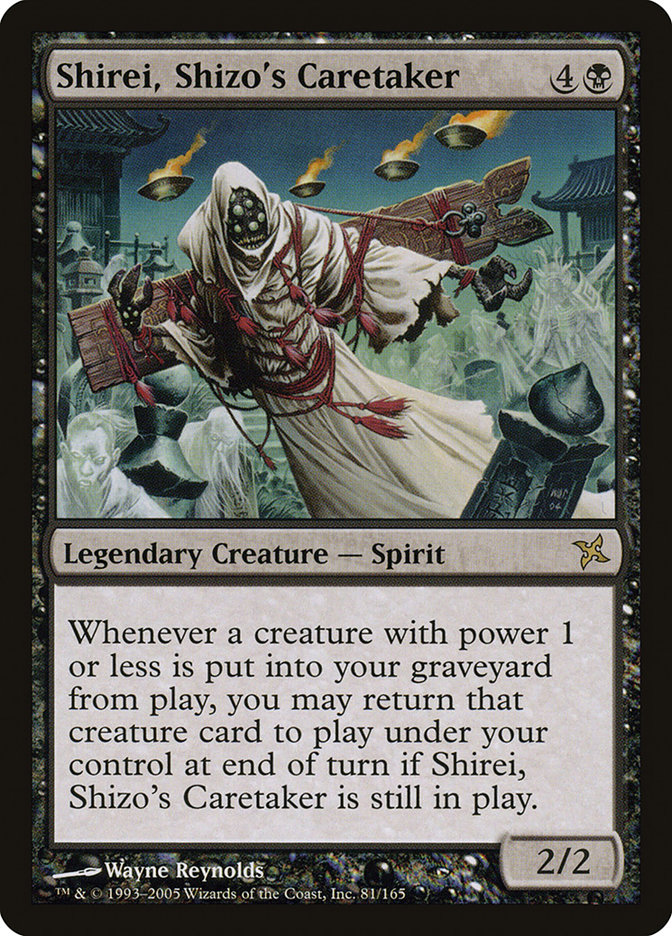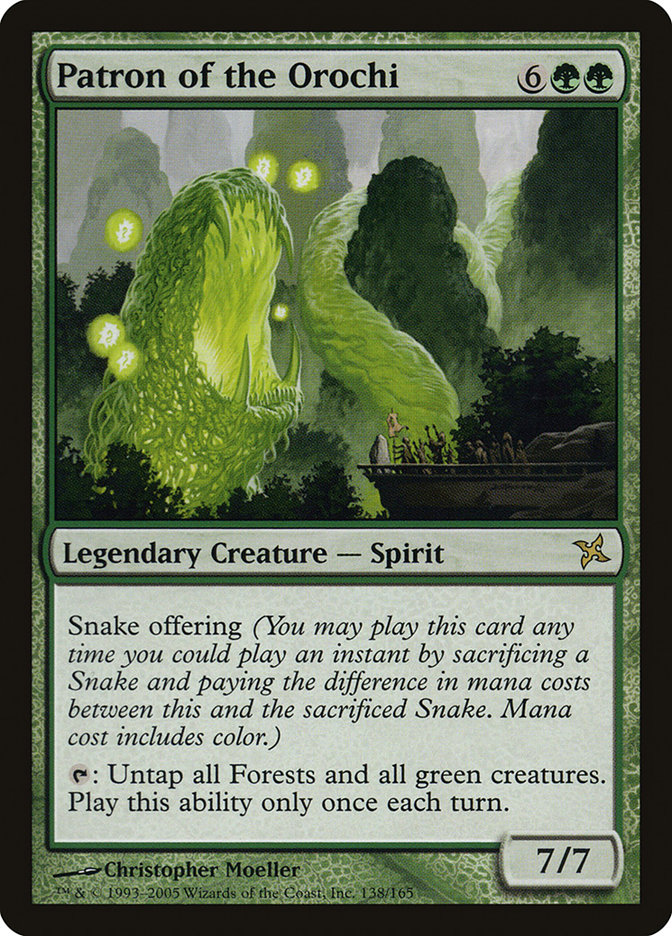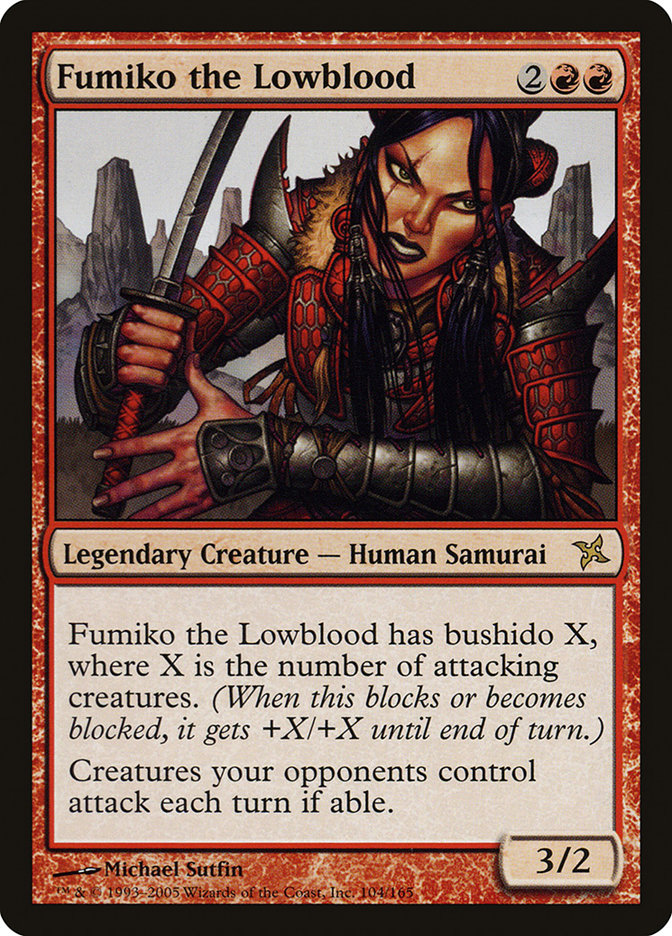I am always happy to defend Champions of Kamigawa. It’s a plucky, underrated set that is remembered poorly simply because it was bookended by the
oppressive Mirrodin-era Standard environment and the sheer ineptitude of Betrayers and Saviors.
But this isn’t Champions of Kamigawa week. It’s Betrayers of Kamigawa week. So instead of busting out comparisons to an underrated Back to the Future
sequel like I did with Champions, I’ll simply say
this:
Betrayers of Kamigawa sure is a set.
There’s more to it than that, of course. Betrayers actually has some interesting and Modern-relevant cards in it, and they’re worth covering as part of The
Modern Series. Plus, if you want to read about everything that happened in Magic this week, you’ve got to stick around for the Betrayers stuff first. It’s
interesting, I promise! I may have even stuck a Guardians of the Galaxy reference in there somewhere.
Betrayers of Kamigawa at a Glance
Betrayers of Kamigawa was released in February of 2005. It was marketed around the most exciting ability in the set: Ninjutsu. Players had been clamoring
for ninjas since the day it was revealed that Kamigawa would be inspired by Japanese mythology, and the time had finally arrived.
Much like Scourge billed itself as ‘the dragon set’ while having only had a small handful of dragons, Betrayers of Kamigawa contained a disappointing eight
ninjas. Only two of these were rares, and one of those was the ninja lord Higure who is awful unless your deck is full of other ninjas. Ninja of the Deep
Hours emerged as a solid staple in Standard, preventing the tribe from being a total bust, but most of us were disappointed that the tribe wasn’t pushed a
little harder. Ninja tribal simply didn’t work, even on the casual level.
The other new keyword was Offering, which allowed you to sacrifice a creature of a certain type to help pay the cost for a bigger and better creature.
While this ability might have been useful in a heavily tribal block, creature types didn’t matter enough in Kamigawa for Offering to be all that useful
outside of limited and casual play.
Betrayers also gave us a cycle of Genju, enchantments that animated your land and allowed them to attack. Once the land died, the Genju would return to
your hand. This was an early attempt by Wizards to make auras tournament playable by attempting to mitigate their downsides, and it actually worked pretty
well. There was a neat infinite combo with Genju of the Fields, and Genju of the Spires became a red deck staple.
Ink-Eyes, Servant of Oni was the prerelease card, and it was the most valuable one for years due to a combination of casual demand and the fact that the
Betrayers of Kamigawa prerelease had very low attendance. Not only was the set unexciting, but the east coast was slammed with a blizzard that weekend,
causing many of the large regional events to be cancelled.
It took about a week and a half after the prerelease for everyone to figure out just how powerful Umezawa’s Jitte actually was, causing the card to jump
from $2 to $20 in an era when that rarely happened. Jitte ended up being the most oppressive card in Standard for the next two years while very few other
cards in Betrayers made an impact.
Betrayers was a decent addition to the Kamigawa block limited format, but it’s hard to defend the mistakes that R&D made with Betrayers of Kamigawa.
The top-down design for the ninjas were solid, but there weren’t enough of them and they weren’t pushed hard enough. Umezawa’s Jitte was too powerful, and
the rest of the set was too weak. There were too many unremarkable rares, and one of the two new abilities–offering –was a total bust. Overall, the set
is remembered as one of the worst in the history of the game.
Some of the cards in Betrayers have stood the test of time though. Let’s look at them one by one, starting with the set’s clear MVP:
Umezawa’s Jitte – $40
Umezawa’s Jitte is one of the most important cards in Legacy. It is one of the linchpins of both aggressive and Stoneforge Mystic-based decks. It is one of
the most powerful, most unfair cards ever printed, and it has been dominant in every non-Vintage format where it has ever been legal.
It isn’t likely to be reprinted again soon either. It already had a turn as a Grand Prix foil, and cards on the Modern banned list are unlikely to show up
in From the Vaults or Commander products. It could show up as a judge foil, but there are only a small handful of those each year. That makes Jitte a very
safe long-term hold.
I wouldn’t start buying these as $40 specs, but it’s a very attractive trade target for the risk adverse. There’s no downside unless Legacy prices drop as
a whole. The upside is that these could eventually run $60-$80 due to scarcity and power level. If you can trade more volatile cards for a Jitte, I
recommend it.
Threads of Disloyalty – $30
Threads of Disloyalty tripled in price this spring when Wild Nacatl and Bitterblossom were unbanned in Modern. At the time, we hoped that Threads would
prove to be excellent sideboard tech against Zoo, Fae, and any deck relying on Tarmogoyf as a win condition. Even though Zoo and Fae have failed to shake
up the format all that much, Threads has still proven itself to be an effective threat in Modern. RUG Twin, U/R Twin, RUG Delver, UWR Control, and some
merfolk builds run this as a one-of or two-of out of their sideboards, and I doubt that will change anytime soon. $30 is the absolute upper limit for this
unless it starts seeing more play because it is still just a sideboard card. A reprint seems likely too, and this will be a $3 rare instantly if it’s
spoiled in Modern Masters II. I’d sell my extra copies before next spring just in case.
Goryo’s Vengeance – $12
Goryo’s Vengeance has been one GP win away from being a $30 card for years. It continues to post solid results from time to time, occasionally showing up
in a Top 8 or two but never making it to the bitter end. I’m higher than most on Modern Reanimator, mostly because the deck has such a strong Legacy
pedigree, and it has fought off an impressive amount of hate for years. I’m not sure what it will take for the deck to truly break out in Modern though.
We’re not getting a better reanimation target than Griselbrand any time soon, and WotC is likely to ban any support/utility cards that would risk making
this deck kill too much faster.
Even still, I doubt that Goryo’s Vengeance will be re-printed unless splice comes back in Modern Masters II, and the breakout potential is still huge. This
is a pretty safe long term hold with massive upside.
Kira, Great Glass-Spinner – $10
Is Merfolk making a comeback in Modern? Check this list out:
Creatures (23)
- 2 Kira, Great Glass-Spinner
- 4 Lord of Atlantis
- 2 Merrow Reejerey
- 4 Silvergill Adept
- 4 Cursecatcher
- 4 Master of the Pearl Trident
- 3 Master of Waves
Lands (20)
Spells (17)
Sideboard

I’m pretty bullish on Merfolk going forward, but even if you think that the reign of Fish is nigh, Kira isn’t the card you want to target. It was just
reprinted at rare in Modern Masters, and copies are still easily available at $6. If you believe in the deck, buy cards with lower print runs like Master
of the Pearl Trident.
Outside of Merfolk, Kira doesn’t see much play. She’s solid enough in U/G Commander decks, but mass removal is more prevalent than the targeted stuff in
casual play, so I end up leaving her out of my final decklists more often than not. She has the upside of a $10-$12 card if Merfolk becomes a solid tier 1
or even tier 2 choice in Modern, but that’s not enough of an increase for me to recommend buying in as a financier. If you’re a collector or deckbuilder
though, grab your Kiras now. She’s not going any lower than $6.
Disrupting Shoal – $10
Disrupting Shoal was a bulk rare for years. It first spiked in September of 2011 thanks to the dominance of Blazing Shoal Infect at Pro Tour Philadelphia,
the first major Modern event in professional Magic. After jumping from $1 to $15, Blazing Shoal was banned, which caused Disrupting Shoal to fall by the
wayside. The card was down to about $2 before Travis Woo re-popularized the card with his Mono-Blue Ninja Bear Delver Deck. It spiked to $10 overnight
earlier this year. Despite seeing zero competitive play for the past six months, the card stubbornly refuses to drop in price. This is mostly because it
‘feels’ like Force of Will, even though it is actually much worse.
It is possible, I suppose, that a card that saw no play in Standard and very little play in Modern could become a staple at some point. For $10 though, I
need to know that a card is actually seeing play somewhere even if it’s just Commander. Right now, Disrupting Shoal’s price tag is based on upside alone.
Mirror Gallery – $6
Mirror Gallery is an odd card. Back when it was printed, the legend rule allowed you to cast a legendary creature that your opponent already had in play in
order to kill them both. Today, your legend and your opponent’s can interact as though they had come from different dimensions.
This chance has certainly made Mirror Gallery worse, but the real downside here is that the card does almost nothing in Commander. Because of the singleton
card limit, the legend rule rarely comes up in that format anyway, and the new rule makes it almost entirely irrelevant. That pretty much leaves Mirror
Gallery as a quirky tool for sixty-card causal decks to abuse in fun ways. That’s nice and all, but it doesn’t add up to a $6 price tag. This card’s only
hope at going up in value is the wide scale adoption of a new casual format that allows you to play more than one of your creatures and spells. Other than
that, well, you’d have to really want to have all three Ajanis in play together or an intense desire to clone your general a bunch.
Ink-Eyes, Servant of Oni – $6
Ink-Eyes, Servant of Oni was an incredibly robust casual rare for years. I never had problems trading them away at retail, and I couldn’t keep them in my
binder for more than a week or two. Once From the Vault: Twenty came out, however, the market flooded and demand dropped to zero. Even though the Betrayers
version books for $6, you can pick up a FTV copy for just $3. That’s probably the bottom, but it’s going to take a few years for demand to outpace supply
again.
Is Ink-Eyes still a good casual card after all these years? Heck yes. Many creatures have lost a step thanks to power creep, but Ink-Eyes’ power level
correlates with the quality of the creature in your opponent’s graveyard. These days, there is always something juicy to nab, and I like running Ink-Eyes
in any black or U/B Commander deck with at least a couple of early game threats. If you’re a Commander player without a copy, snag one at $3. It can’t go
any lower.
Tendo Ice Bridge – $5
Tendo Ice Bridge was sweet tech in post-ban Mirrodin/Kamigawa Standard when you wanted to power up your Etched Oracles and draw a bunch of free cards.
These days, Tendo Ice Bridge finishes a distant fourth in the five-color land race, well behind Mana Confluence, City of Brass, and Gemstone Mine. Other
than seeing play as a one-of in Matthias Hunt’s Amulet of Vigor deck, Ice
Bridge has been absent from professional tournaments over the past few months. It’s not great in casual play either where games take longer and your cards
need to be more versatile. I am usually bullish on every older land, but at $5, Ice Bridge is overrated. It has been outclassed by too many other cards at
this point.
Final Judgment – $5
Final Judgment is one of the better wrath effects in Commander. By exiling creatures instead of destroying them, you’re getting rid of all the
indestructible nonsense while also preventing your opponents from abusing their graveyards. People can still put their Commanders in the Command Zone, of
course, which is why tuck effects like Hallowed Burial are better most of the time. Even still, Final Judgment is a better call in most decks than, say,
Wrath of God.
I don’t think Final Judgment can go up in price much more though. Because tuck effects are so much better, this card only comes into play as a budget
option or in decks that need more than a few board sweepers. I also think that it stands a good shot of being reprinted, perhaps even in an expert level
set. If so, the price will drop to $2-$3. It’s okay to own a few of these for Commander play, but it’s a poor spec target.
That Which Was Taken – $4
Are there any keywords that casual players enjoy more than ‘Indestructible?’ I doubt it, which is why That Which Was Taken is a fun card to dream on.
Because it can make anything indestructible, Johnnies can brew up all kinds of amusing shenanigans and scenarios using the card. Indeed, seeing one of
these in play against you with tons of mana open can be kind of daunting.
While That Which Was Taken gets a near-perfect score on the uniqueness scale, its actual power level is fairly low. Even if you suit up a bunch of your
permanents, divinity counters mean nothing if someone kills That Which Was Taken. So if you’re looking to build competitively in Commander, look elsewhere.
That Which Was Taken also seems like it will be reprinted in Commander 2014, doesn’t it? Take away the flavor text, change the art, and there’s nothing too
Kamigawa-ish about it. If it is reprinted, it’ll drop to $0.50 overnight too. I’m staying away.
Sowing Salt – $4
Sowing Salt is an important sideboard card in Modern, allowing red combo and control decks (Kiki, Jund, UWR Control) to have a solid answer against Tron.
It is mostly used as a sideboard one-of though, much like Threads of Disloyalty. Even worse, it’s an uncommon that has been printed twice: once in
Betrayers of Kamigawa and once in Urza’s Destiny. Considering the disparity between supply and demand, I can’t imagine the price going much higher than
this. It could be a solid $5-$6 on the trading floor of a large Modern event if players are expecting a lot of Tron, but I doubt the book price will
permanently rise again.
Shirei, Shizo’s Caretaker – $4
Shirei’s text may prevent infinite loops, but it’s still a solid source of card advantage if you’re willing to work for it. I’ve seen people try and build
around Shirei in Modern, usually with some combination of Blood Artist, Kami of False Hope, and Fume Spitter, but the entire engine hinges around getting a
five mana 2/2 into play and keeping it around while you durdle a bunch. That’s, like, a tier five interaction. At best.
Shirei is a little better in Commander, but there isn’t a whole lot to combine it with in mono-black. The optimal Shirei deck needs green to function, so
it makes for kind of a lousy general. It’s possible that WotC will print enough creatures that work well with Shirei to make it an effective Commander at
some point, but that day is years off at best. It’s stuck in neutral–and at $4–for a while.
Patron of the Orochi – $4
Don’t be fooled by the ‘snake offering’ part of Patron of the Orochi’s rules text. Unless you’ve got a Mystic Snake lying around that you want to get into
the graveyard for some reason, you’ll be paying full price here. The good news is that this card isn’t great to cheat into play anyway–the more Forests
you have lying around, the better it gets.
I’ve only seen Patron of the Orochi used in mono-green decks, but it is worth considering in Simic Commander decks as well, acting as a supplement to
Seedborn Muse/Prophet of Kruphix shenanigans. If you are already building your deck around ramp spells and untapping things a whole bunch, this guy is a
solid role player. Based on the fact that I doubt we’ll see the Patron again soon, I like this as a long term casual hold. It’s sold out right now at $4,
and I could see it re-stocking in the $6-$8 range.
Fumiko the Lowblood – $3
Fumiko’s $3 price tag has nothing to do with her first ability and everything to do with her second one. Huge multiplayer games of Commander can often be a
slog, with players amassing giant armies full of creatures that sit around looking impressive until someone casts a wrath. Fumiko forces everyone to play
Red’s game, speeding things up considerably and forcing everyone into combat whether they’re ready or not. Three dollars seems reasonable for a general who
is interesting without being broken. Even though I can’t see her being reprinted anytime soon, her upside is limited to nonexistent.
Wait–I forgot to add that Guardians of the Galaxy reference I promised you! Uh, crap. I don’t learn. One of my issues.
This Week’s Trends
apoplectic. When considered in conjunction with the end of mandated PTQ seasons, many on Twitter were calling it the death of Modern. This is simply not
the case. First off,
Aaron Forsythe (allegedly) said that the backlash to this change was unexpected and they’re reconsidering it
. There will also be more Modern GPs in 2015 than there were in 2014: eight instead of six. Modern will see much greater support next season now
that it is part of the Open Series on Sundays. Wizards has said that Modern will be a regionals format too, and it will certainly be a Prelims format in
places where Modern is popular. This isn’t like the old Extended, where the format was universally hated and people only played it because they were forced
to; people love Modern and it is still growing in popularity. Don’t sell those staples just yet.
cards will jump in price as people start buying into decks that had previously been out of their price range.
seems to be dedicated to engaging people in Standard for twelve straight months. If that is WotC’s goal for next year, then it makes sense to highlight the
format during each Pro Tour. This will backfire in a major way if Standard is stale and boring, but if it isn’t, expect Standard to be front and center
more than it ever has been.
2015, with locations and formats to be announced. This will almost assuredly be release weekend for Modern Masters II. I would be shocked if it isn’t the
case.
point, and they were certainly heading in the direction. If Modern Masters II is a very similar set, however, these boxes will probably drop back down
toward $230-$250. If the set is significantly different–and especially if MMII doesn’t have Dark Confidant and Tarmogoyf in it–I could see these
continuing their upward climb. Holding these for the long term is much more of a gamble now though, and I can no longer recommend it. I’ll be looking to
sell in October or November when the overall market has rebounded a little.
the card has actually gone up in price since the promo was released. The influx of new copies will probably keep the price of Griselbrand from getting out
of control at any point soon though, which is nice.
at least as far as Magic finance goes. Standard is about a month away from rotation, so very few people are buying right now. The breakout card of
the event was Goblin Rabblemaster, but cheap red stuff never makes for a great spec. It only went up to $4, and I bet it’ll fall a bit from there. If you
bought in at $2 on the way up, you probably won’t have much of a chance to profit at this point.
nadir of the summer, and next week I’ll be advising you on which cards to pick up for the fall.

